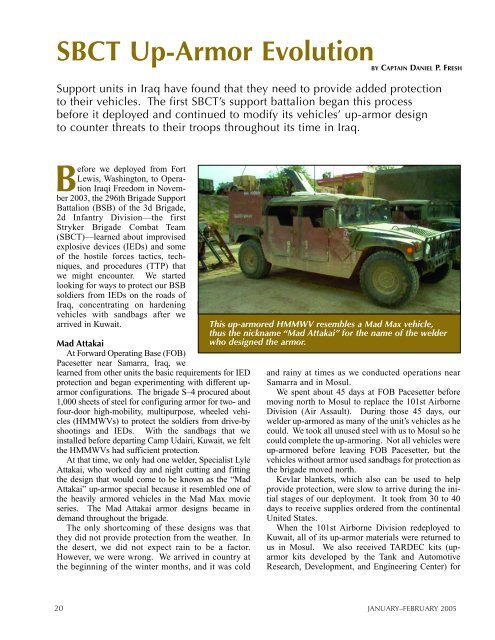Supporting the First Stryker Brigade in Iraq - Army Logistics ...
Supporting the First Stryker Brigade in Iraq - Army Logistics ...
Supporting the First Stryker Brigade in Iraq - Army Logistics ...
You also want an ePaper? Increase the reach of your titles
YUMPU automatically turns print PDFs into web optimized ePapers that Google loves.
SBCT Up-Armor EvolutionBY CAPTAIN<br />
Before we deployed from Fort<br />
Lewis, Wash<strong>in</strong>gton, to Operation<br />
<strong>Iraq</strong>i Freedom <strong>in</strong> November<br />
2003, <strong>the</strong> 296th <strong>Brigade</strong> Support<br />
Battalion (BSB) of <strong>the</strong> 3d <strong>Brigade</strong>,<br />
2d Infantry Division—<strong>the</strong> first<br />
<strong>Stryker</strong> <strong>Brigade</strong> Combat Team<br />
(SBCT)—learned about improvised<br />
explosive devices (IEDs) and some<br />
of <strong>the</strong> hostile forces tactics, techniques,<br />
and procedures (TTP) that<br />
we might encounter. We started<br />
look<strong>in</strong>g for ways to protect our BSB<br />
soldiers from IEDs on <strong>the</strong> roads of<br />
<strong>Iraq</strong>, concentrat<strong>in</strong>g on harden<strong>in</strong>g<br />
vehicles with sandbags after we<br />
arrived <strong>in</strong> Kuwait.<br />
Mad Attakai<br />
At Forward Operat<strong>in</strong>g Base (FOB)<br />
Pacesetter near Samarra, <strong>Iraq</strong>, we<br />
learned from o<strong>the</strong>r units <strong>the</strong> basic requirements for IED<br />
protection and began experiment<strong>in</strong>g with different uparmor<br />
configurations. The brigade S–4 procured about<br />
1,000 sheets of steel for configur<strong>in</strong>g armor for two- and<br />
four-door high-mobility, multipurpose, wheeled vehicles<br />
(HMMWVs) to protect <strong>the</strong> soldiers from drive-by<br />
shoot<strong>in</strong>gs and IEDs. With <strong>the</strong> sandbags that we<br />
<strong>in</strong>stalled before depart<strong>in</strong>g Camp Udairi, Kuwait, we felt<br />
<strong>the</strong> HMMWVs had sufficient protection.<br />
At that time, we only had one welder, Specialist Lyle<br />
Attakai, who worked day and night cutt<strong>in</strong>g and fitt<strong>in</strong>g<br />
<strong>the</strong> design that would come to be known as <strong>the</strong> “Mad<br />
Attakai” up-armor special because it resembled one of<br />
<strong>the</strong> heavily armored vehicles <strong>in</strong> <strong>the</strong> Mad Max movie<br />
series. The Mad Attakai armor designs became <strong>in</strong><br />
demand throughout <strong>the</strong> brigade.<br />
The only shortcom<strong>in</strong>g of <strong>the</strong>se designs was that<br />
<strong>the</strong>y did not provide protection from <strong>the</strong> wea<strong>the</strong>r. In<br />
<strong>the</strong> desert, we did not expect ra<strong>in</strong> to be a factor.<br />
However, we were wrong. We arrived <strong>in</strong> country at<br />
<strong>the</strong> beg<strong>in</strong>n<strong>in</strong>g of <strong>the</strong> w<strong>in</strong>ter months, and it was cold<br />
20<br />
DANIEL P. FRESH<br />
Support units <strong>in</strong> <strong>Iraq</strong> have found that <strong>the</strong>y need to provide added protection<br />
to <strong>the</strong>ir vehicles. The first SBCT’s support battalion began this process<br />
before it deployed and cont<strong>in</strong>ued to modify its vehicles’ up-armor design<br />
to counter threats to <strong>the</strong>ir troops throughout its time <strong>in</strong> <strong>Iraq</strong>.<br />
This up-armored HMMWV resembles a Mad Max vehicle,<br />
thus <strong>the</strong> nickname “Mad Attakai” for <strong>the</strong> name of <strong>the</strong> welder<br />
who designed <strong>the</strong> armor.<br />
and ra<strong>in</strong>y at times as we conducted operations near<br />
Samarra and <strong>in</strong> Mosul.<br />
We spent about 45 days at FOB Pacesetter before<br />
mov<strong>in</strong>g north to Mosul to replace <strong>the</strong> 101st Airborne<br />
Division (Air Assault). Dur<strong>in</strong>g those 45 days, our<br />
welder up-armored as many of <strong>the</strong> unit’s vehicles as he<br />
could. We took all unused steel with us to Mosul so he<br />
could complete <strong>the</strong> up-armor<strong>in</strong>g. Not all vehicles were<br />
up-armored before leav<strong>in</strong>g FOB Pacesetter, but <strong>the</strong><br />
vehicles without armor used sandbags for protection as<br />
<strong>the</strong> brigade moved north.<br />
Kevlar blankets, which also can be used to help<br />
provide protection, were slow to arrive dur<strong>in</strong>g <strong>the</strong> <strong>in</strong>itial<br />
stages of our deployment. It took from 30 to 40<br />
days to receive supplies ordered from <strong>the</strong> cont<strong>in</strong>ental<br />
United States.<br />
When <strong>the</strong> 101st Airborne Division redeployed to<br />
Kuwait, all of its up-armor materials were returned to<br />
us <strong>in</strong> Mosul. We also received TARDEC kits (uparmor<br />
kits developed by <strong>the</strong> Tank and Automotive<br />
Research, Development, and Eng<strong>in</strong>eer<strong>in</strong>g Center) for<br />
JANUARY–FEBRUARY 2005







